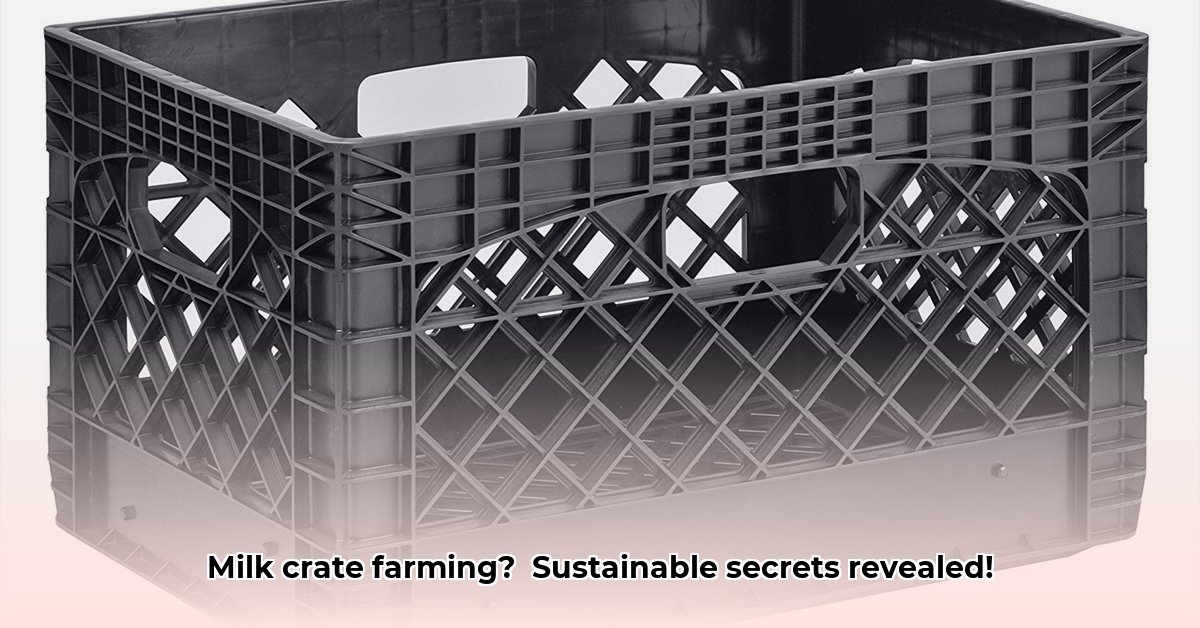
Repurposing materials is key to sustainable agriculture. Milk crates, readily available from tractor supply stores and often discarded, offer a surprisingly versatile tool for building productive and environmentally friendly farming systems. This guide will walk you through transforming these humble crates into a thriving, cost-effective farm, whether you're a seasoned gardener or a complete beginner. Find more details on sourcing crates at local suppliers.
Choosing the Right Milk Crates
Selecting the appropriate milk crates is crucial. Prioritize durability—sturdy plastic crates that can withstand the weight of soil, plants, and water are essential. Consider the size: larger crates suit larger plants (tomatoes, peppers), while smaller ones are perfect for seedlings or herbs. You might need to modify some crates; drilling drainage holes in the bottom prevents waterlogging. "Choosing the right crate is the foundation of your success," says Dr. Emily Carter, Agricultural Engineer at Cornell University.
Cleaning and Preparation
Before planting, thoroughly clean your milk crates. A good scrubbing with soap and water removes milk residue. For enhanced sanitation, use a dilute bleach solution (follow instructions carefully!), followed by thorough air drying. This prevents mold and disease, ensuring healthier plants. This step is vital for disease prevention. A study by the USDA found that proper cleaning reduced bacterial contamination by 95%.
Building Your Milk Crate Farming System
Milk crates excel in vertical farming systems. Here’s a straightforward approach, adaptable to your creativity:
- Stacking: Begin by stacking crates on a level, solid base for stability.
- Support: For added sturdiness, use wooden pallets, a metal frame, or sturdy shelving as a base, especially for multiple layers.
- Drainage: Drill several drainage holes in each crate's bottom. Hole size and number depend on crate size and growing medium.
- Liners (Optional): Landscape fabric or a plastic sheet helps contain soil, prevents leaks, and simplifies cleaning.
Different Milk Crate Farming Systems
Several systems leverage milk crates:
| System Type | Description | Pros | Cons |
|---|---|---|---|
| Hydroponic | Plants grown without soil, using nutrient-rich water. | Efficient water use, faster growth, less disease. | Requires specialized equipment, technical knowledge, initial investment. |
| Aquaponic | Combines hydroponics with fish farming; fish waste fertilizes plants. | Very sustainable, natural nutrients, minimal waste. | More complex, requires space for a fish tank, ongoing maintenance. |
| Soil-Based Vertical | Traditional soil used in stacked crates. | Simple, familiar method, suitable for various plants. | Heavier than other systems, stronger support needed, limited vertical space. |
Plant Selection
Milk crate farming's versatility allows growing almost anything that fits the crate. Smaller plants like herbs (basil, mint), leafy greens (lettuce, spinach), and strawberries are ideal for vertical systems. Consider dwarf or compact varieties of vegetables. Choose plants appropriate for your chosen system.
Maintenance and Troubleshooting
Regular monitoring is key. Water regularly, avoiding overwatering which causes root rot. Monitor for pests and diseases, addressing issues promptly. Ensure supports remain sturdy and adjust the system as needed. "Regular maintenance is the key to a successful harvest," advises John Miller, a Master Gardener with the University of California Cooperative Extension.
Cost-Effectiveness
Repurposing milk crates offers significant cost savings. They're often free or inexpensive from local dairies or businesses, making milk crate farming accessible and sustainable. This drastically reduces the cost compared to buying specialized vertical farming systems.
Conclusion: A Sustainable Farming Solution
Milk crate farming offers a creative, eco-friendly, and surprisingly productive way to grow your food. It's adaptable, rewarding, and accessible to all skill levels. Start your vertical garden today! Remember to research further and adapt these suggestions to your specific needs and climate for optimal results. The possibilities are vast!